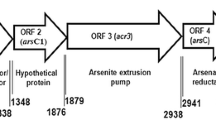Abstract
The ArsA ATPase is the catalytic subunit of a pump that is responsible for resistance to arsenicals and antimonials in Escherichia coli. Arsenite or antimonite allosterically activates the ArsA ATPase activity. ArsA homologues from eubacteria, archaea and eukarya have a signature sequence (DTAPTGHT) that includes a conserved histidine. The ArsA ATPase has two such conserved motifs, one in the NH2-terminal (A1) half and the other in the COOH-terminal (A2) half of the protein. These sequences have been proposed to be signal transduction domains that transmit the information of metal occupancy at the allosteric to the catalytic site to activate ATP hydrolysis. The role of the conserved residues His148 and His453, which reside in the A1 and A2 signal transduction domains respectively, was investigated by mutagenesis to create H148A, H453A or H148A/H453A ArsAs. Each altered protein exhibited a decrease in the V max of metalloid-activated ATP hydrolysis, in the order wild type ArsA>H148A>H453A>H148A/H453A. These results suggest that the histidine residues play a role in transmission of the signal between the catalytic and allosteric sites.
Similar content being viewed by others
References
Bhattacharjee H, Ghosh M, Mukhopadhyay R, Rosen BP. 1999 Ar-senic transporters from E. coli to humans in Broome-Smith JK, Baumberg S, Sterling CJ, Ward FB (Eds), Transport of molecules across microbial membranes, Society for General Micriobiology, pp. 58–79.
Bhattacharjee H, Li J, Ksenzenko MY, Rosen BP. 1995 Role of cys-teinyl residues in metalloactivation of the oxyanion-translocating ArsA ATPase. J Biol Chem 270, 11245–11250.
Bhattacharjee H, Rosen BP. 1996 Spatial proximity of Cys113, Cys172, and Cys422 in the metalloactivation domain of the ArsA ATPase. J BiolChem 271, 24465–24470.
Hsu CM, Rosen BP. 1989 Characterization of the catalytic subunit of an anion pump. J BiolChem 264, 17349–17354.
Karkaria CE, Chen CM, Rosen BP. 1990 Mutagenesis of a nucleotide-binding site of an anion-translocating ATPase. J Biol Chem 265, 7832–7836.
Kaur P, Rosen BP. 1992 Mutagenesis of the C-terminal nucleotide-binding site of an anion-translocating ATPase. J Biol Chem 267, 19272–19277.
Li J, Rosen BP. 2000 The linker peptide of the ArsA ATPase. Mol Microbiol 35, 361–367.
Mukhopadhyay R, Li J, Bhattacharjee H, Rosen BP. 1998 Metalloid resistance mechanisms in Rosen BP, Mobashery S (Eds), Rosolv-ing the antibiotic paradox, Plenum Publishers, pp. 159–181.
Ramaswamy S, Kaur P. 1998 Nucleotide binding to the C-terminal nucleotide binding domain of ArsA: Studies with an ATP ana-logue, 5'-p-fluorosulfonylbenzoyladenosine. J Biol Chem 273, 9243–9248.
Rosen BP, Bhattacharjee H, Zhou T, Walmsley AR. 1999 Mecha-nism of the ArsA ATPase. Biochim Biophys Acta 1461, 207–215.
Rosen BP, Weigel U, Karkaria C, Gangola P. 1988 Molecular characterization of an anion pump. The arsA gene product is an arsenite(antimonate)-stimulated ATPase. J BiolChem 263, 3067–3070.
Sambrook J, Fritsch EF, Maniatis T. 1989 Molecular cloning, a laboratory manual. Cold Spring Harbor Laboratory.
Vogel G, Steinhart R. 1976 ATPase of Escherichia coli: purification, dissociation, and reconstitution of the active complex from the isolated subunits. Biochemistry 15, 208–216.
Walker JE, Saraste M, Runswick MJ, Gay NJ. 1982 Distantly related sequences in the α-and β-subunits of ATP synthase, myosin, kinases and other ATP-requiring enzymes and a common nu-cleotide binding fold. EMBO Journal 1, 945–951.
Zhou T, Radaev S, Rosen BP, Gatti DL. 2000 Structure of the ArsA ATPase: the catalytic subunit of a heavy metal resistance pump. Embo J, 19, 4838–4845.
Zhou T, Rosen BP. 1997 Tryptophan fluorescence reports nucleotide-induced conformational changes in a domain of the ArsA ATPase. J Biol Chem 272, 19731–19737.
Zhou TQ, Rosen BP. 1999 Asp45 is a Mg2+ ligand in the ArsA ATPase. J BiolChem 274, 13854–13858.
Author information
Authors and Affiliations
Rights and permissions
About this article
Cite this article
Bhattacharjee, H., Rosen, B.P. Role of conserved histidine residues in metalloactivation of the ArsA ATPase. Biometals 13, 281–288 (2000). https://doi.org/10.1023/A:1009200215328
Issue Date:
DOI: https://doi.org/10.1023/A:1009200215328




